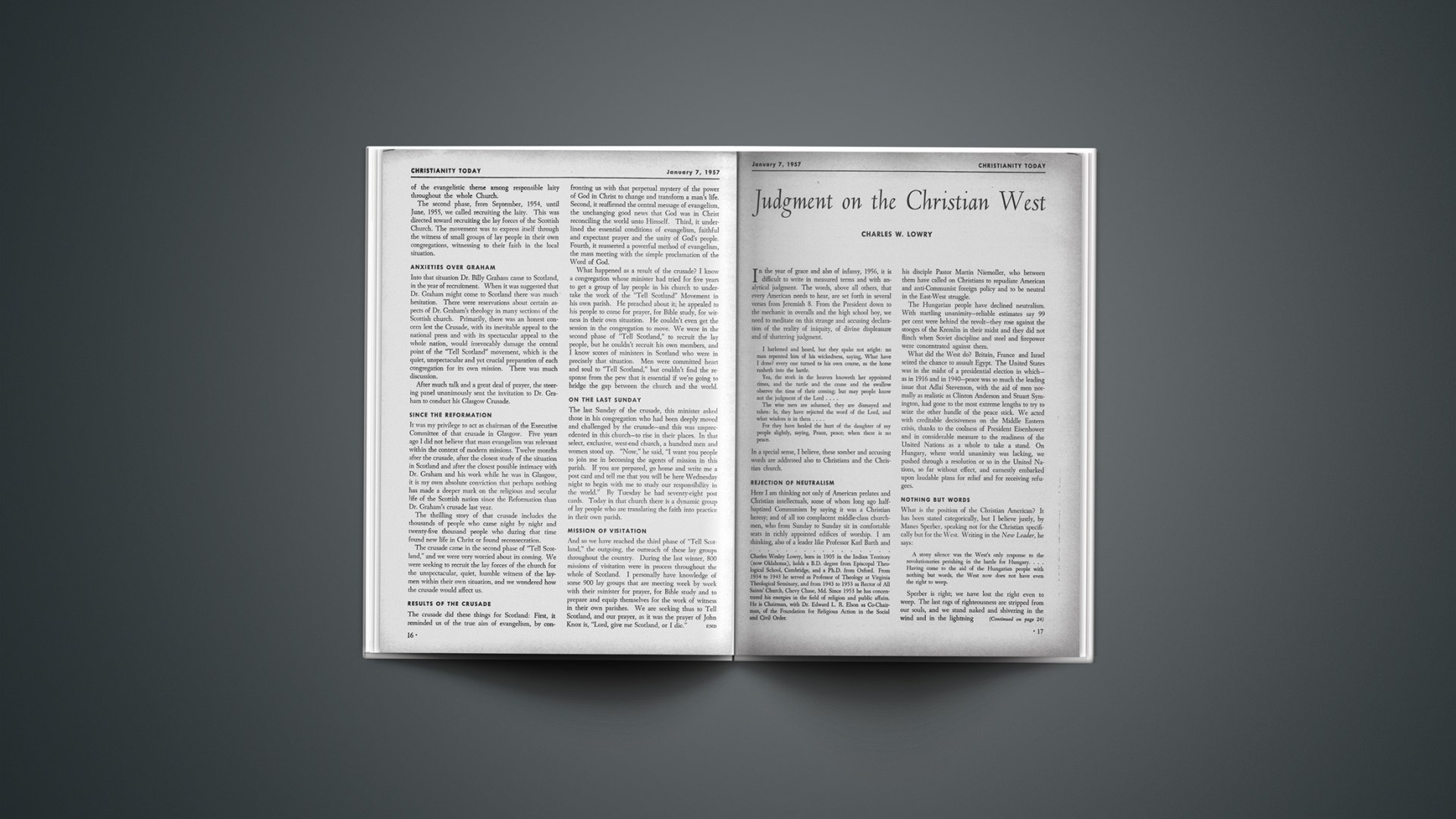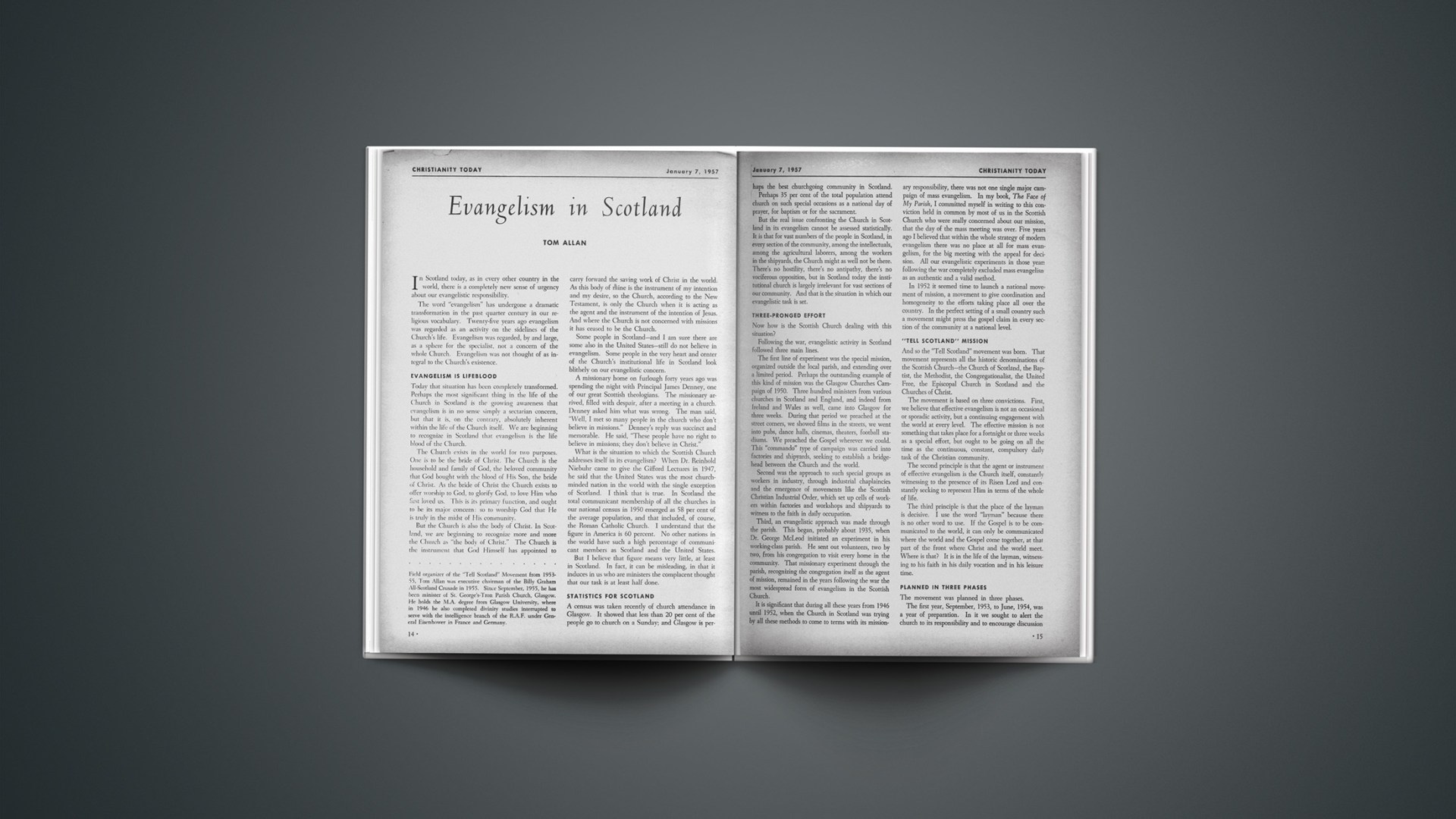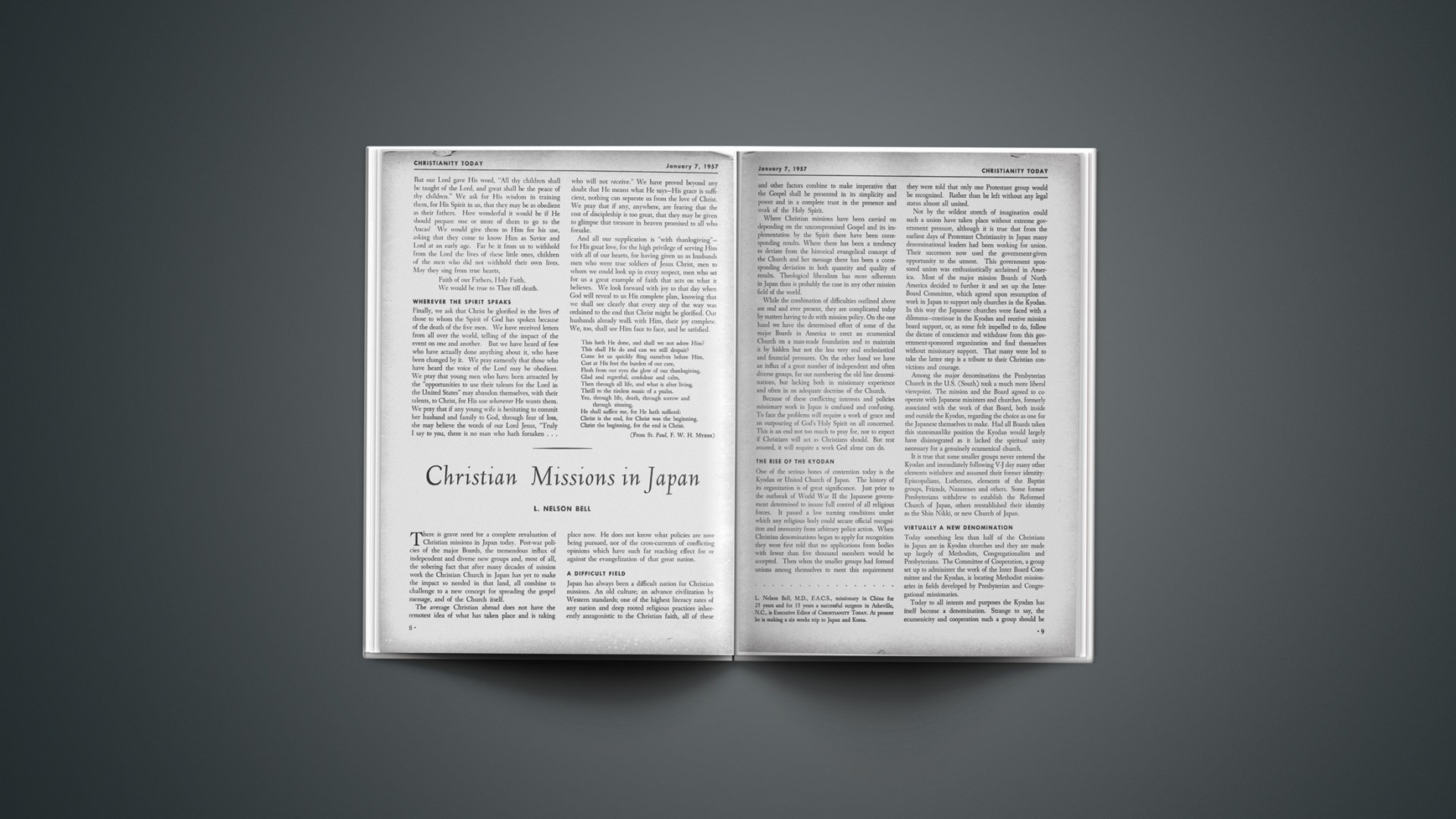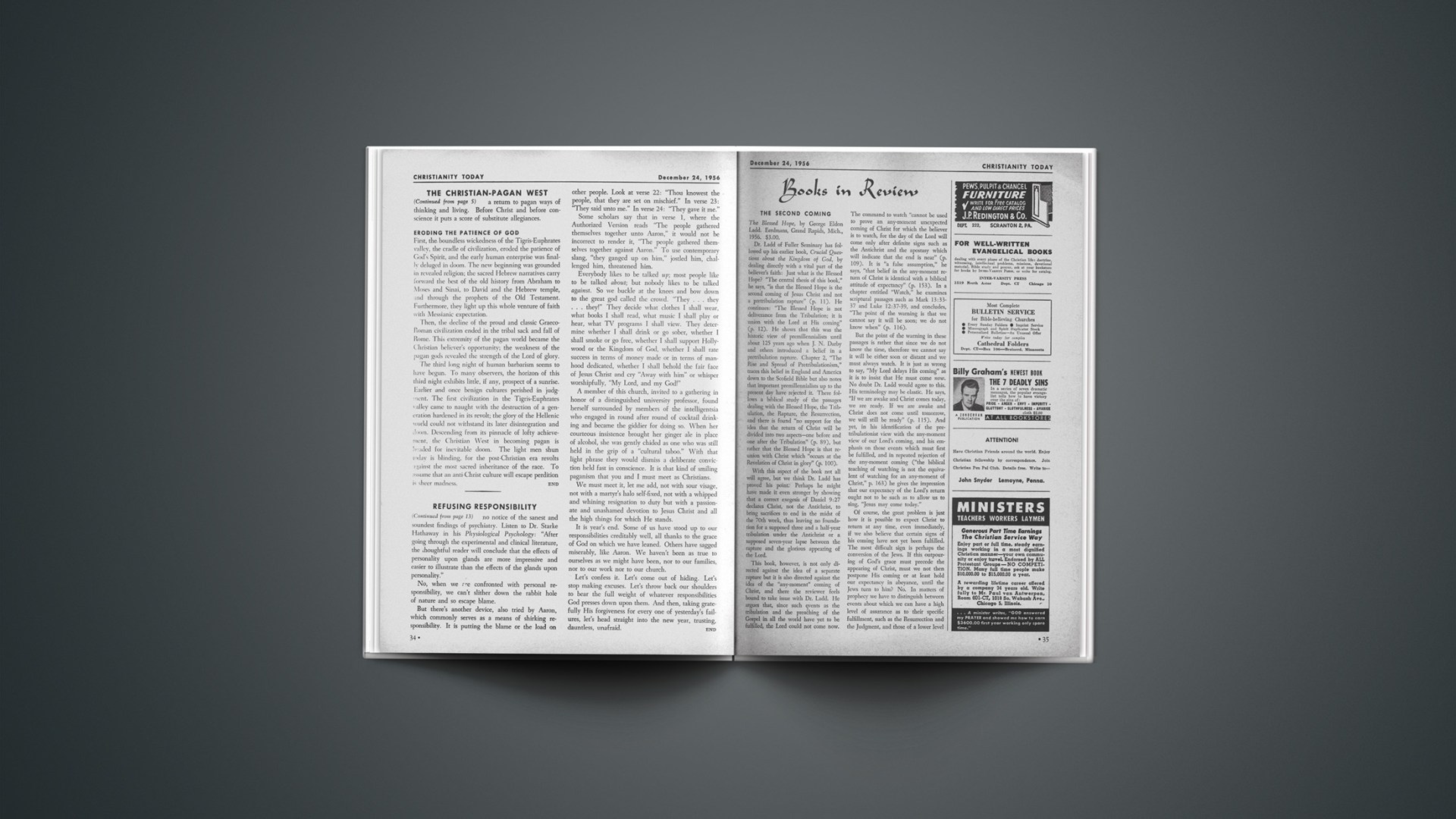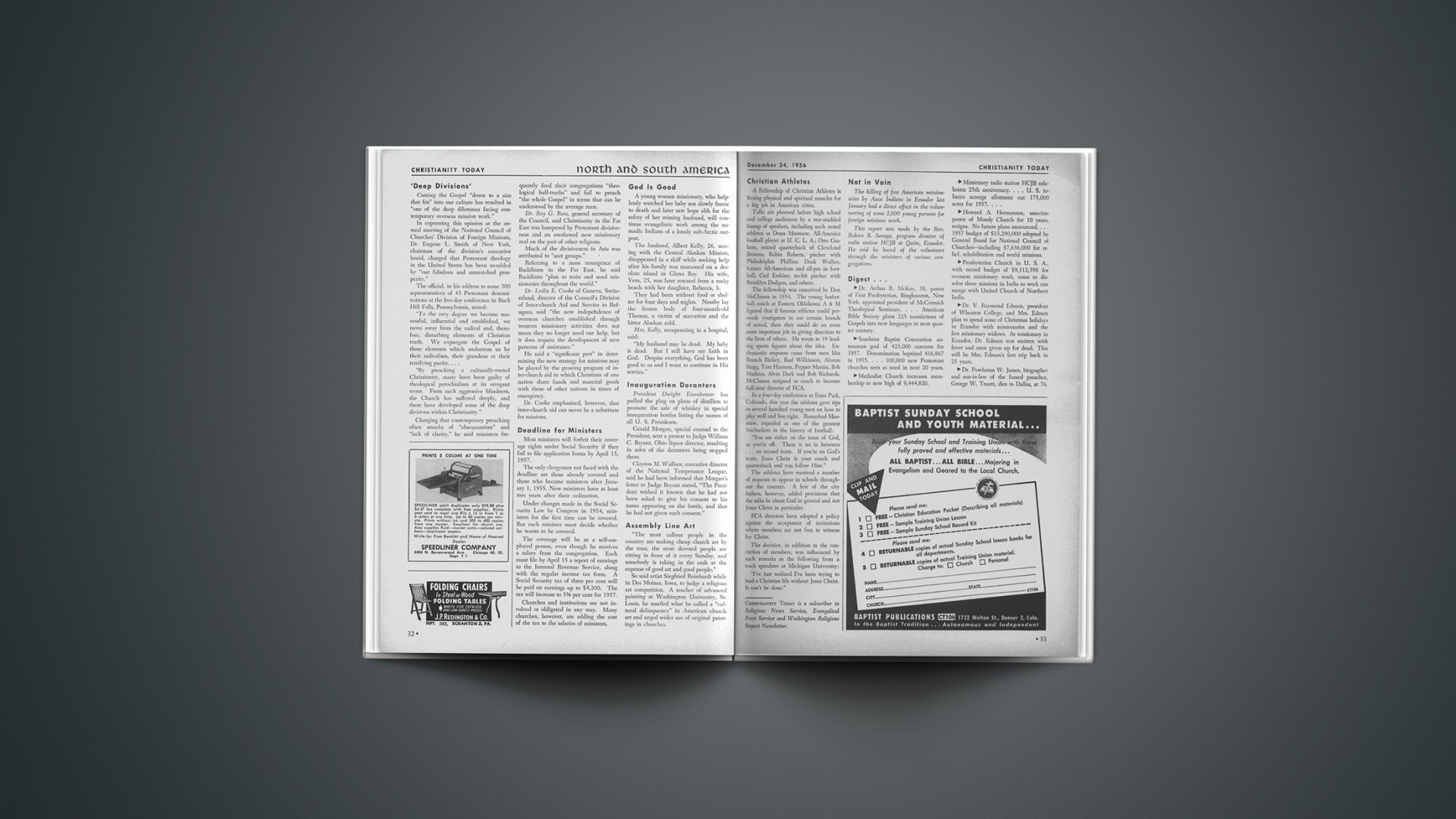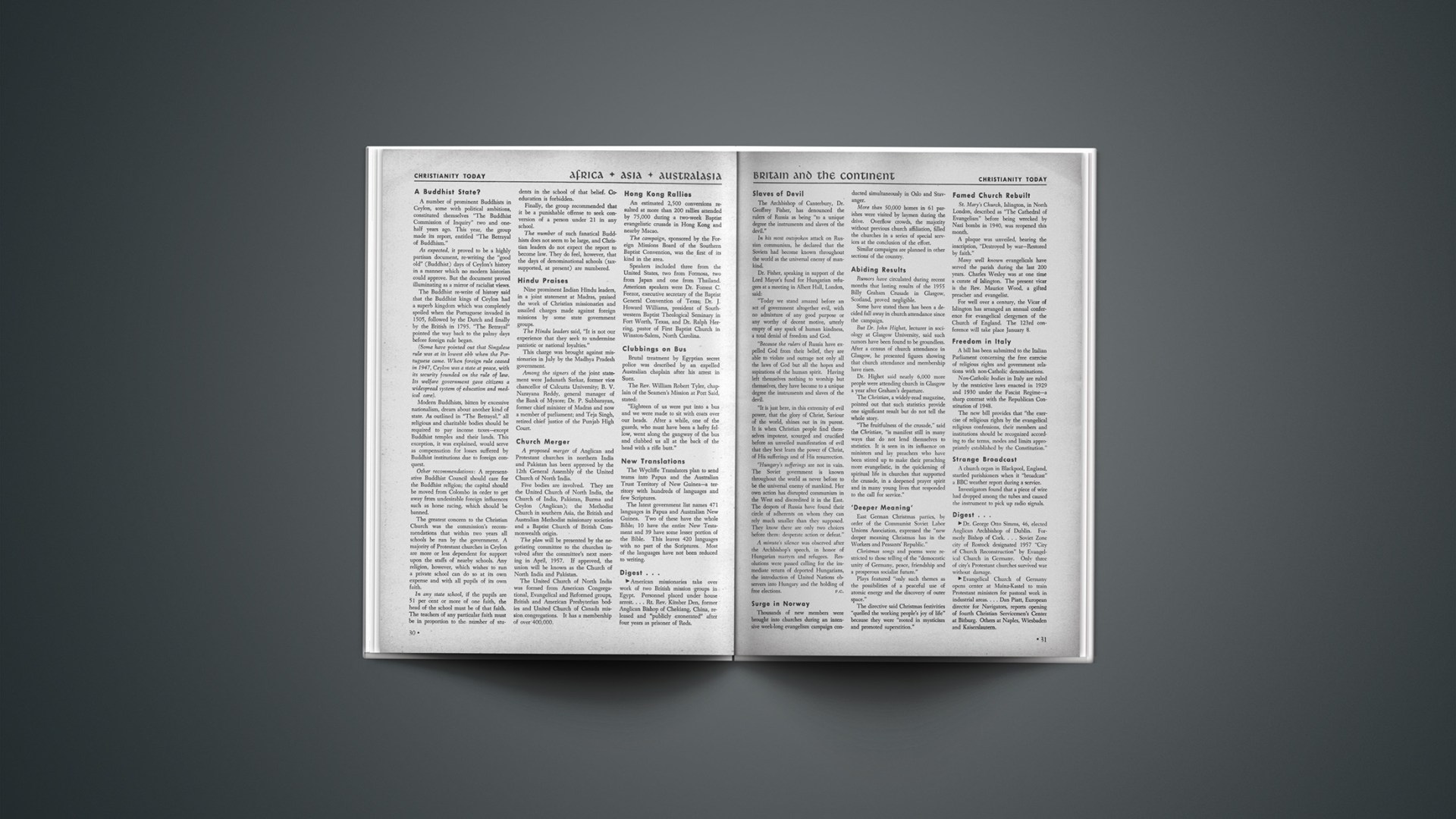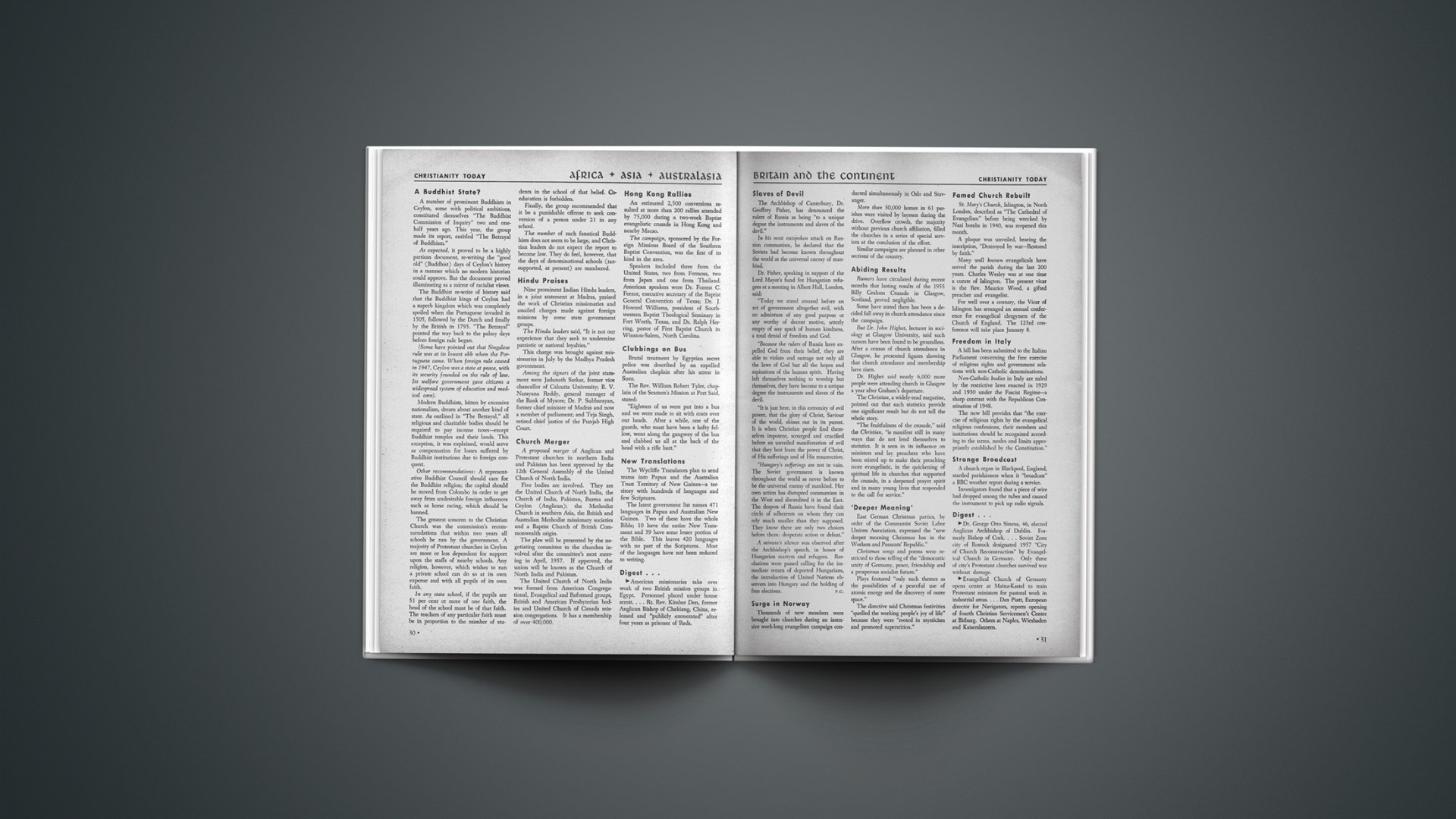In the year of grace and also of infamy, 1956, it is difficult to write in measured terms and with analytical judgment. The words, above all others, that every American needs to hear, are set forth in several verses from Jeremiah 8. From the President down to the mechanic in overalls and the high school boy, we need to meditate on this strange and accusing declaration of the reality of iniquity, of divine displeasure and of shattering judgment.
I harkened and heard, but they spake not aright: no man repented him of his wickedness, saying, What have I done? every one turned to his own course, as the horse rusheth into the battle.
Yea, the stork in the heaven knoweth her appointed times, and the turtle and the crane and the swallow observe the time of their coming; but may people know not the judgment of the Lord.…
The wise men are ashamed, they are dismayed and taken: lo, they have rejected the word of the Lord, and what wisdom is in them.…
For they have healed the hurt of the daughter of my people slightly, saying, Peace, peace; when there is no peace.
In a special sense, I believe, these somber and accusing words are addressed also to Christians and the Christian church.
Rejection Of Neutralism
Here I am thinking not only of American prelates and Christian intellectuals, some of whom long ago half-baptized Communism by saying it was a Christian heresy; and of all too complacent middle-class churchmen, who from Sunday to Sunday sit in comfortable seats in richly appointed edifices of worship. I am thinking, also of a leader like Professor Karl Barth and his disciple Pastor Martin Niemoller, who between them have called on Christians to repudiate American and anti-Communist foreign policy and to be neutral in the East-West struggle.
The Hungarian people have declined neutralism. With startling unanimity—reliable estimates say 99 per cent were behind the revolt—they rose against the stooges of the Kremlin in their midst and they did not flinch when Soviet discipline and steel and firepower were concentrated against them.
What did the West do? Britain, France and Israel seized the chance to assault Egypt. The United States was in the midst of a presidential election in which—as in 1916 and in 1940—peace was so much the leading issue that Adlai Stevenson, with the aid of men normally as realistic as Clinton Anderson and Stuart Symington, had gone to the most extreme lengths to try to seize the other handle of the peace stick. We acted with creditable decisiveness on the Middle Eastern crisis, thanks to the coolness of President Eisenhower and in considerable measure to the readiness of the United Nations as a whole to take a stand. On Hungary, where world unanimity was lacking, we pushed through a resolution or so in the United Nations, so far without effect, and earnestly embarked upon laudable plans for relief and for receiving refugees.
Nothing But Words
What is the position of the Christian American? It has been stated categorically, but I believe justly, by Manes Sperber, speaking not for the Christian specifically but for the West. Writing in the New Leader, he says:
A stony silence was the West’s only response to the revolutionaries perishing in the battle for Hungary.… Having come to the aid of the Hungarian people with nothing but words, the West now does not have even the right to weep.
Sperber is right; we have lost the right even to weep. The last rags of righteousness are stripped from our souls, and we stand naked and shivering in the Wind and in the lightning and thunder of the just judgment of Almighty God.
Perhaps, however, not so much to say anything pious or wise, but in order not to keep silent, as St. Augustine once said in a very different context, we can meditate on the extraordinary predicament in which Christendom is and in which Christians are. Perhaps it is not being presumptuous to do this, if we realize that Christianity has a special responsibility for Communism. In a sense the latter is the Christian West’s unintended, but definite and fantastic, gift to the world.
Predicament Of Christendom
What are the hard facts? First, communism arose in the West, specifically in Germany and Great Britain with a considerable French infusion. Second, Karl Marx, the Moses of Communism as Engels was the Aristotle, was a baptized Christian and an Evangelical at that—which in Europe means a Lutheran. We Christians commonly speak of Marx as a Jew, and in favor of this is the fact that he was very Jewish in his mind and soul.
A third fact is that the materials which went into composing communism as a system were drawn from Western philosophy, scientific progress, industrialism and social conditions in the nineteenth century. A fourth fact is the astonishing assimilation in Communism as a doctrinal and mythological system to the Bible and Christianity. This can be shown by a doctrine-to-doctrine comparison, such as is worked out in my book Communism and Christ. It must, however, be stressed that this is an example of unconscious thinking.
It is a result certainly unintended by Marx who was passionately sincere, subjectively, in his conviction that religion is the opiate of the people, the dope administered by beneficiaries of capitalism, and the leading obstacle to social and historical progress.
Communism is as far as ancient Gnosticism from being in the normal sense of the phrase a Christian heresy. It is rather an opposed and a competing system, controlled by diametrically antagonistic premises; and it is in a very nearly exact sense the expression in twentieth-century terms of the spirit of Antichrist. It seeks deliberately, strategically, uncompromisingly and with fierce, inhuman hostility to extirpate the influence, teaching and name of Jesus Christ.
The confusion, division, rationalization and compromise of Christians in relation to this issue are surely a marvel of the present age which future historians will find scarcely credible.
The fifth and final fact to be noted is that Communism as a creed and a universal salvation system has been exported from West to East, thus reversing a religious trend of thousands of years.
The Demonic In History
So much for what is. If, next, we ask why this is, the answer is very difficult and can be either brief and summary, or very long drawn out and complicated, with every facet of modern history brought into the story. We must give the short answer.
The Bible teaches us that there is a great mystery about faith. Indeed, the apostle Paul says that the short and simple truth about living Christian faith is that it is God’s gift. This applies in principle, also, to every powerful expression of faith and to the primacy of the will to believe in human existence.
From this standpoint there is no rational explanation of the faith of Marxism-Leninism, aptly named for two of the great believers of history. Reason can list and link together many important conditioning factors and circumstances, but the final explanation must be assigned to the mysteries of human freedom, the power of the demonic and the satanic in history, and divine providence and judgment.
The Judgment Of God
Particularly important is the last named explanatory factor, divine providence and judgment. The biblical and Christian view of history is that God is everlastingly at work in His world both as Creator-Lover and as Judge. While we may well shrink from facing and accepting the relation—for “it is a fearful thing to fall into the hands of the living God”—there can be no doubt that God is related in a most important way to the astounding, total phenomenon of Communism.
Communism, also stripped at this moment of its last hypocritical pretension and standing naked in all its hideous, inner ugliness, represents the fearful divine verdict on Christian and Western civilization: “Thou art weighed in the balances, and art found wanting.” That is, Communism denotes both in its curious origin and in its extraordinary expansion the existence of a grave sickness in Western culture. This sickness is primarily of the soul and therefore concerns most intimately the Christian Church.
The heart, literally, of a civilization is the values which are generally accepted by its people and which are the cardinal motives of life in its manifold phases. Communism stabs us awake because its values are explicit and are in violent, deliberate contrast with those the West has received and taken for granted. What we generally fail to realize is that Communism could not have arisen and certainly could not have advanced so spectacularly without a preparatory loss of faith in transcendent reality and a secularization and materialization of values.
What of us in the United States? To some extent we have missed or at least blunted the secularization that has swamped Europe, including Great Britain. There are widespread indications of religious revival in our country as a whole and there are our fantastic church statistics. According to Dr. Will Herberg, more than 95 per cent of all Americans actually identify themselves religiously.
Liberty More Than Life
Yet soon after the merciless rape of Hungary by the Soviets, I heard a former Soviet Colonel of Intelligence “Meet the Press” of America. The half hour in which this took place was one of the most uncomfortable I have ever spent. Four top news correspondents set out to obtain for the American TV audience a story from the Colonel who had repudiated communism and “the inhuman communist system.” They never got much of a story, for their minds and that of their guest never met. They felt the Hungarian revolt was a failure. They wanted the Colonel to comment on the harsh dilemma of the captive peoples. He never conceded failure even in the slightest degree and he really never accepted a question those crack inquisitors gave him. Each time he would tilt or transpose the question so as to bring it over into a different dimension of existence.
The devastating climax of the interview came when the young ex-Soviet Colonel so very mildly said that it seemed to him that our main purpose in America was to stay alive. For the people of East Europe, on the contrary, this was not the situation. For them existence under the communist system had become intolerable and liberty mattered more than life.
Behind this attractive, apparently baffling young Russian I seemed to see and hear distant figures like Patrick Henry, Sam Adams and our first Congressmen who adopted on July 4, 1776, a ringing declaration of defiance even against death. But I could not see that this got through to the American reporters. They seemed to be fixated in another, flatter dimension, the dimension of peace, prosperity, and “don’t topple the applecart” in which most of us seem to be living.
The Inner Meaning
“Thou art weighed in the balances, and art found wanting.” Is this indeed the inner meaning of Communism in relation to the Christian West?
On this question Christian Americans must think and think furiously. Communist tyranny is crumbling, though no man can say what streets of desolation and rivers of young blood must still be added to the holocaust of Budapest. Milovan Djilas, former close friend of Tito and Vice President of Yugoslavia, says that the uprising of the Hungarian people is comparable in significance to the French and the Russian revolutions. It means that the whole Communist system is on the way out. For this confession Tito jailed him.
Where will we be in that day? Possibly just where we are—comfortable, fabulously prosperous, obsessed with the desire for peace at any price, finding it incredible that men and women, boys and girls could fling their lives away with calculated abandon.
“Whosoever shall seek to save his life shall lose it; and whosoever shall lose his life shall preserve it.” These words still determine the ultimate course of this world, and in our age of anxiety and storm, the purposes of the Kingdom “not of this world” are strangely fulfilled.
Charles Wesley Lowry, born in 1905 in the Indian Territory (now Oklahoma), holds a B.D. degree from Episcopal Theological School, Cambridge, and a Ph.D. from Oxford. From 1934 to 1943 he served as Professor of Theology at Virginia Theological Seminary, and from 1943 to 1953 as Rector of All Saints’ Church, Chevy Chase, Md. Since 1953 he has concentrated his energies in the field of religion and public affairs. He is Chairman, with Dr. Edward L. R. Elson as Co-Chairman, of the Foundation for Religious Action in the Social and Civil Order.

